- Emergency responders: Grady Brooks, Mark Ferris, Bob Triplett and Mike Ball voluntarily plunged into 14 feet of raw sewage filling the basement floor of a dark pump station on April 30. photos by Max Cooper
- Problem solvers: MSD managers Peter Weed, left, and Ken Stines stand beside an inflow pump; the knife gate is above.
- Knife gate: This 400-pound knife gate — which closes off sewage flowing into the pump station — blew out of position April 30, leading to a shutdown that caused a major spill.
- From the top: “We had a plan in place, and it wasn't followed,” says MSD General Manager Tom Hartye.
The 400-pound stainless steel plate shot out of its casing, knocking Steve Sigman off the scaffolding. After crashing into a concrete wall and denting it, the massive plate landed on top of him as he lay curled up on the bare basement floor.
Raw sewage poured out of the opening at a rate of roughly 300 gallons a minute. Soon, nearby manholes began overflowing into the French Broad River. All hell had broken loose on Riverside Drive. (photos by Max Cooper)
The Metropolitan Sewerage District of Buncombe County collects and treats the wastewater from some 48,000 residences, 6,000 businesses and 22 industries within its service area. Each day, about 20 million gallons of sewage flows through about 900 miles of collection lines into the 60-mile complex of interceptors that deliver it to the basement of the pump station where the April 30 accident took place. There, three large pumps raise the sewage 30 feet above the intake level to begin the treatment process.
Nearing the end of its 25-year useful life, the 1,500-pound pump No. 3 was slated for replacement. A contractor, Gilbert Engineering Co. of Statesville, had been hired to do the job, which included repacking the knife gate. In the open position, the sliding, inch-thick plate allows sewage to flow into the pump; when closed, it cuts off the flow.
A dry run conducted by MSD staff clocked 48 minutes from the time all three pumps were turned off until backed up sewage would threaten an overflow. The repacking process would take approximately 25 minutes. The contractor was given those parameters and told to have MSD turn off all three pumps before any work began.
But the signal to kill the pumps was never given.
The contractor's three-man crew — Foreman Don Sigman and his two sons, Keith and Steve — arrived at the three-story pump station around 7:15 a.m., accompanied by MSD inspector Mike Schraven. Instead of notifying plant personnel to turn off the pumps, however, they simply went to work on repacking the gate.
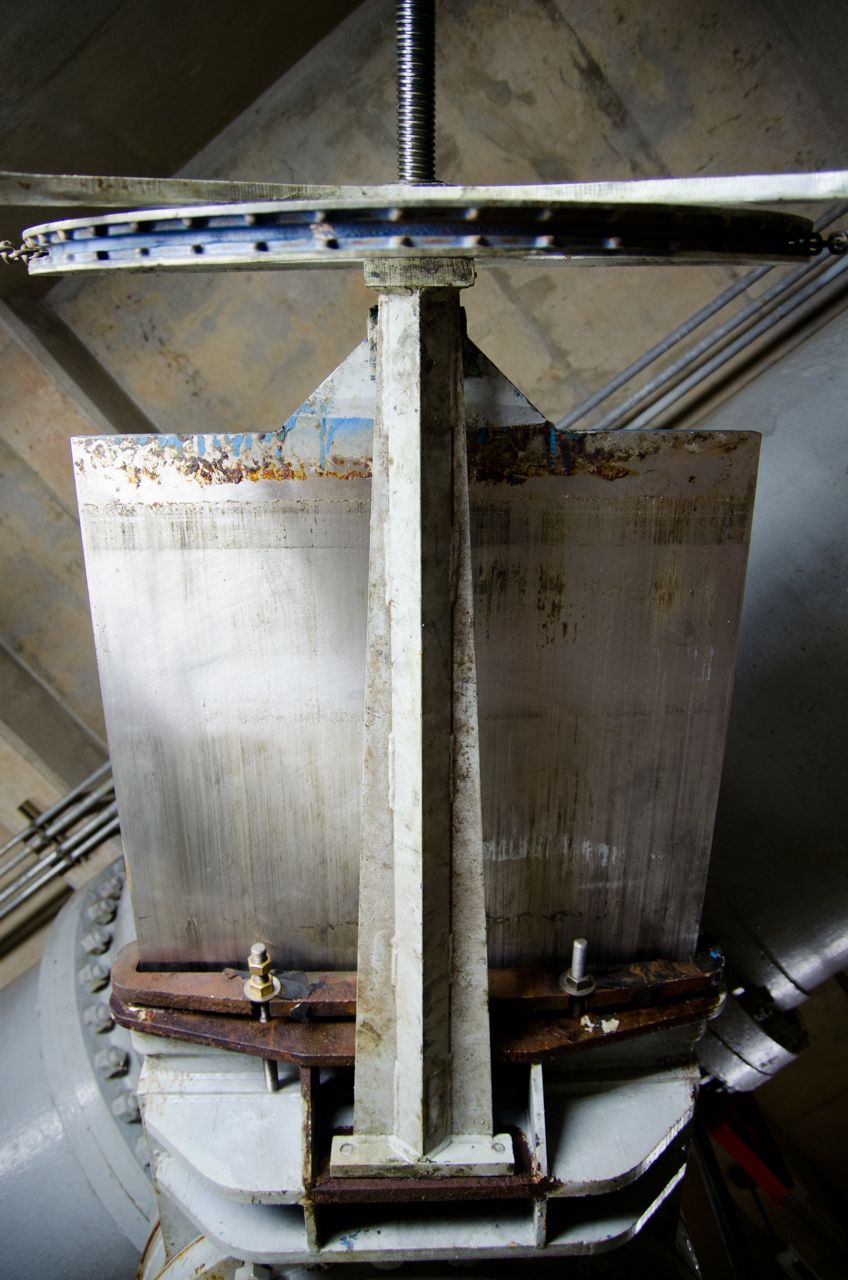
The effluent in the line to pump No. 3 was under considerable pressure; when the knife gate flew out, raw sewage rapidly spilled over the 30-by-50-foot basement floor. Keith and MSD staffer Bob Triplett got the plate off Steve’s chest and helped him up the stairs. At Mission Hospital’s emergency room, they stapled a gash in Steve’s scalp and released him.
Meanwhile, Schraven turned off the pumps. But that didn’t stanch the sewage spewing from the open slot in pump No. 3.
Down shit creek
One backbone of MSD's operating strategy is an emergency procedure called “code red.” A code-red alarm quickly pulls together a team that assembles at the building where bypass pumps, various types of piping and other specialized equipment are carefully maintained and stored.
"They know what their assignment is, what hoses and pumps they're supposed to get," explains Ken Stines, director of system services maintenance. The code-red crew then scurries to the emergency site, ready to erect a bypass around the blockage, if necessary, until repairs can be made.
"It's made a tremendous difference in our overall volume of spills," Stines reports. "Most are relatively low, because we either get it over with fairly quickly or we bypass the flow around the problem."
But no one was expecting a code-red summons to the treatment plant itself.
Minutes after receiving a hurried call from General Manager Tom Hartye, Stines was on-site. Sizing up the situation, he immediately contacted the dispatcher on his hand-held radio, saying, "Call a code red to the treatment plant."
In the short time it took his responders to get to the site, the wastewater in the basement reached a depth of 14 feet. At that point, sewage overflowed from the manhole behind MSD's administration building and began entering the French Broad.
Several hours later, the code-red team had pumped out enough effluent that maintenance responders could access the basement pumps. Triplett and three other volunteers — Mike Ball, Mark Ferris and Grady Brooks — took on a cold, wet challenge, plunging into several feet of raw sewage while still more wastewater shot out of the slot.
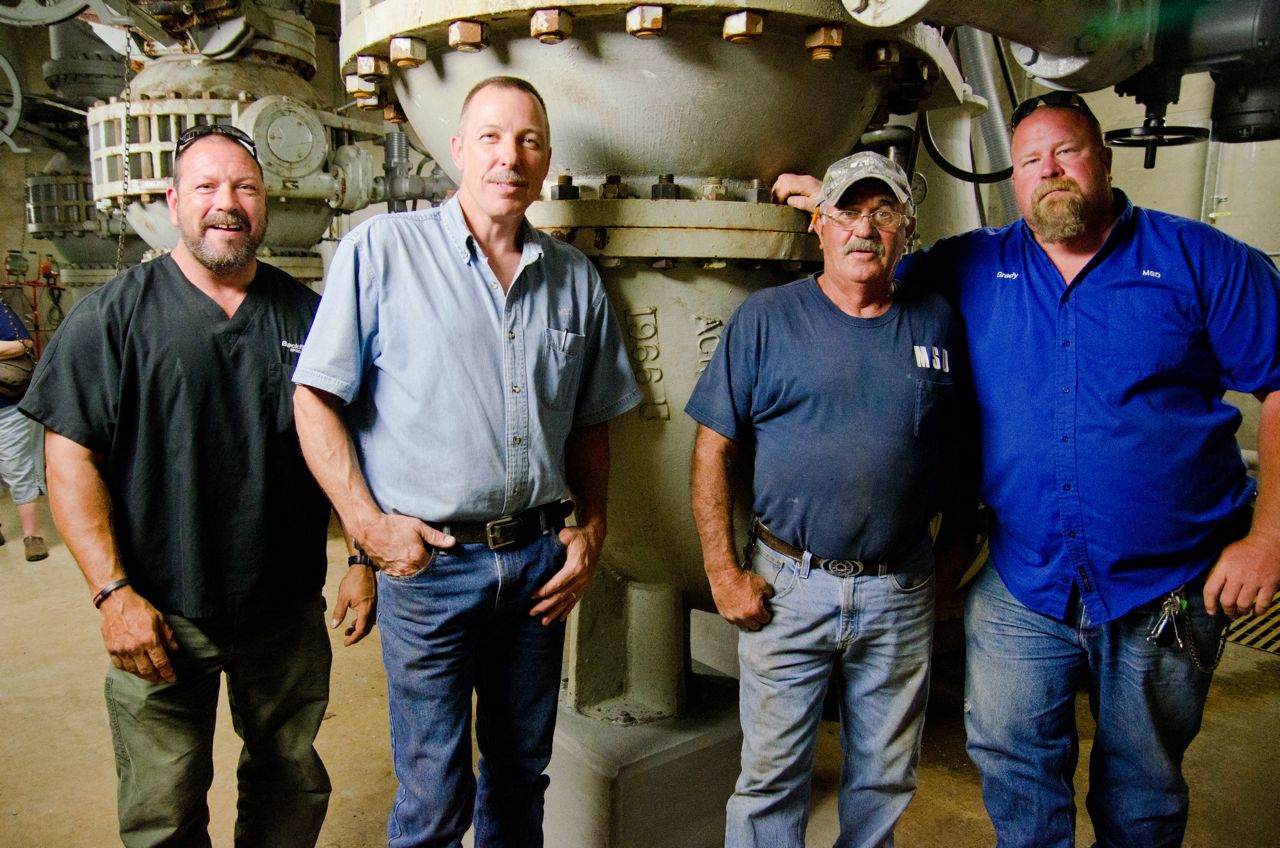
The code-red team on April 30: Mike Ball, Mark Ferris, Bob Triplett and Grady Brooks
They worked in near darkness: Electricity to the basement had been turned off because of the flooding. But somehow they managed to locate the submerged knife gate and the smaller yoke needed to reclose the valve.
It took all four men to hoist the massive, 30-by-40-inch plate. (Coincidentally, Ferris is a world-class power lifter.) Pushing against the relentless flow of water, they pounded the gate into place with wooden wedges. Then they began stuffing the slot with 3/4-inch rope, which kept blowing back out. Eventually, they were able to apply the flange to keep the packing in.
When they finally emerged into the warm daylight air above, the wastewater’s 55-degree temperature had so chilled them that their breath came out as fog.
Backup backs up
MSD runs a tight ship, which sails on a wide sea of redundancy. The pump that was the source of the April spill was actually a backup to the two main pumps.
"The project that was going on was to replace a pump so that this type of thing wouldn't happen," Hartye explains. "It was a 20- to 25-year-old pump.” All MSD pump stations have at least two pumps. “One,” he continues, “can run the entire flow; the other one's there as a backup. That's part of the design, and it became a requirement” from the state Department of Environment and Natural Resources.
"We have one room all organized here with all the emergency pumps for those stations," says Peter Weed, director of wastewater treatment, operation and maintenance. And those backups, he notes, are "quite costly."
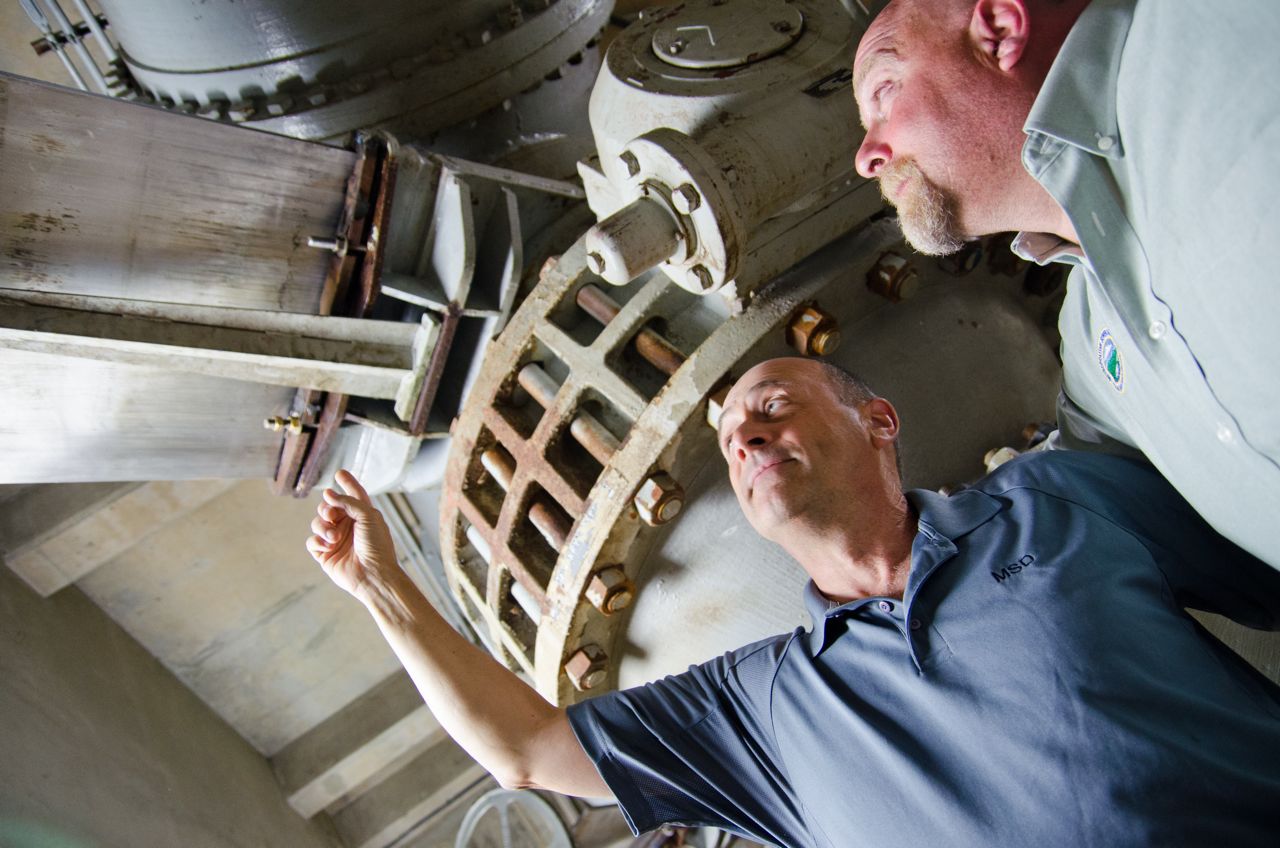
Peter Weed and Ken Stines show where the knife gate is located; on April 30, the 400-pound piece flew off, and millions of gallons of sewage spewed out.
Including capital improvements and debt service, MSD devotes two-thirds of its annual budget to upgrading the infrastructure. As a result, “sanitary system overflows” have decreased significantly over the past 13 years, Hartye reports. That aggressive ongoing rehab, he points out, has also contributed greatly in upgrading the French Broad River’s water-quality classification from a class C to a class B.
"We're kind of sore about the whole thing," Hartye says of the April 30 accident. "It didn't need to happen. We had a plan in place, and it wasn't followed. This organization spends 24/7, 365 days a year trying to minimize these types of incidents, so we're pretty upset."

While the four volunteers wrestled with the knife gate, additional team members were either working to close other valves in the basement or were upstairs manning the portable pumps. Plant operators were on hand to make sure everything was properly disengaged and then turned back on. Up the hill, the drivers of two flusher trucks pulled water out of the "grit-and-grease" holding area in an effort to keep more effluent from flowing back down to the pump station.
For the next few days, workers monitored the river, taking water samples all the way down to Hot Springs. Crews had been quickly dispatched to post warning signs at the affected parks.
State water-quality officials had been notified immediately, before any sewage even reached the river. Local health departments were brought into the loop, along with town officials and assorted river users. News crews converged on the treatment plant, feeding the public updates on the dire situation.
The spill lasted six hours and 10 minutes, from 8:35 a.m. to 2:45 p.m., flowing at a rate of almost 1 million gallons per hour. Heavy rains helped dilute the spill: The river’s flow had swelled to more 190 million gallons per hour. By 8 p.m. that day, MSD crews had removed contaminated surface soils, disinfected and mulched around the manholes that had overflowed.
And by Thursday morning — just two days later — water quality in the French Broad tested within the normal range all the way down to Hot Springs.
Best-laid plans
A few weeks later, MSD supervisors assembled in an upstairs meeting room in the administration building, talking candidly about the spill.
Asked what their reactions had been when they arrived at the site, they were momentarily silent. "Two words," someone said, and then they all erupted into laughter. "Oh, shit," translated Stines. "That, and then, 'Get it fixed.'"
The agency has received a notice of violation from the state Division of Water Quality. After MSD provides a more detailed response, a fine will be levied for the discharge, says Chuck Cranford, the regional office supervisor. Overall, though, he characterizes the MSD’s record as "really exemplary."
"This was just an unfortunate accident," he observes. "It's a shame it happened.”
The clamor surrounding the spill was set against the broader background of state lawmakers’ controversial attempt to unilaterally place Asheville’s water system under MSD’s management (which the city is challenging in court). Asked if staff morale had suffered due to those events, the assembled supervisors grew thoughtful.
"It's embarrassing," said Weed. "But I was just blown away with the response of the crew and overall staff at the incident. It was just admirable. Afterward, I really got angry that [the spill] ever happened — and at a terrible time when, yes, we're in the spotlight."
"Just to have this on our record," commented Ed Bradford, director of capital improvement. "We've got such a strong record that's recognized by legislators, the regulators, and then to have this happen — it's just disappointing. Regardless of the political things going on with the water."
"The water [issue] is very small," Hartye observed. "The water is de minimis compared to this spill. The water just increased the optics of it, I guess."
"I think people view us as kind of a third party sometimes," said Stines, "like we're trying to make money. It's important that we're nonprofit. Our job is to protect the environment."
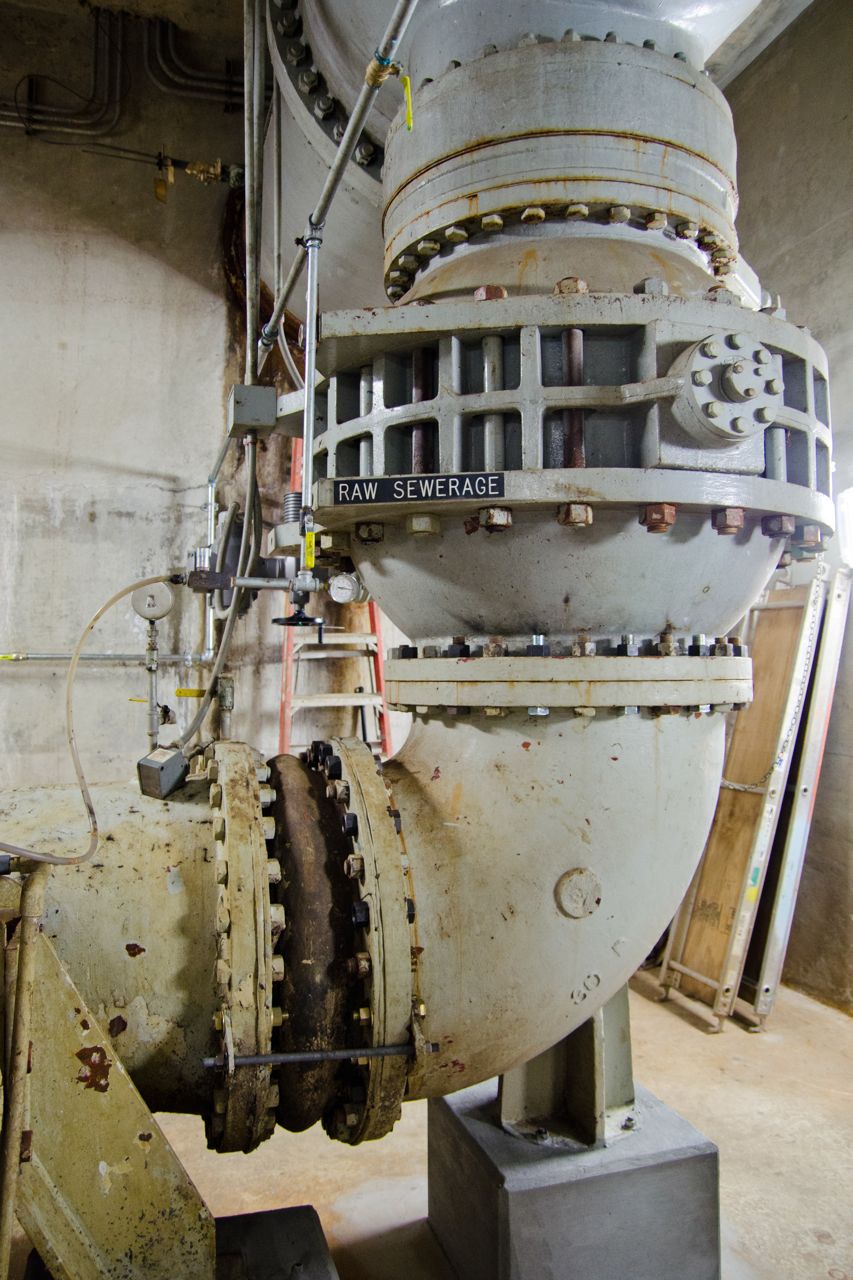
The agency, he pointed out, maintains a "critical crossing" book with full plans for handling emergencies at the most crucial points where sewer lines cross water, such as the Carrier Bridge pump station (which typically handles 7 to 8 million gallons of sewage a day but may get up to 18 mgd in heavy rain).
"We've got the plans of how many pumps we'd need, where we'd pump to. It's all laid out … blueprints, a plan and a guideline. So when it happens, all I've got to do is go grab that book," Stines pointed out.
Despite the best-laid plans, however, human error does occur. And in the end, these staffers could come up with only one way to ensure that there would never be a repeat of the April 30 spill. “The only consideration,” said Stines, “is outhouses.”
— Nelda Holder can be reached at nfholder@gmail.com.


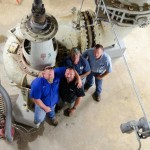





“Red-Ahhhhhhhhhhh, they saved every one of us!”
After reading that account of being literally up poop’s creek, I don’t complain about my job anymore.
http://www.royalglassbahrain.com/myanmarcycling/8b684-97220-50.htmlニューバランス 店舗 埼玉,ニューバランス576gて何?,も定番も今 なら限定 プライス!送料無料!即日配送多数あり!,ニューバランス 574 ブルー
ニューバランス 574 人気,ニューバランススニーカースタイル,安い価格で、しかしそこにあなたの選択のための100%本物の品質で好評発売幅広い。,楽天ニューバランスシューズ http://horselovermagazine.com/myanmarcycling/84152-67218-37.html
http://wordpressthemesforwriters.com/myanmarcycling/708ce-87214-4.htmlニューバランススニーカー,ニューバランス 574 ブルー,正規品店舗!100% 品質保障!全国送料無料でお 届け☆ 。,ニューバランス スニーカー ペア
ニューバランス1400 ネイビー,ニューバランス レディース 996,新商品!品質100% 保証第一最速商店,ニューバランス 人気 カラー http://christopherwall.org/wp-content/newbalance/a643a-07226-97.html
http://oceandivers.com.au/newbalance/8dd95-07221-55.htmlニューバランス 店舗 梅田,ニューバランス 996 ホワイト,- 全商品低価格通販中![再入荷!!送料無料!!海外限定],ニューバランス 1300 最安値
アローズ ニューバランス 梨花,アローズ ニューバランス 梨花,本物の卸売,ニューバランス 店舗 東京 http://www.evidenceaid.org/myanmarcycling/7a510-27216-20.html